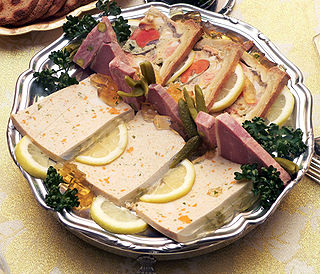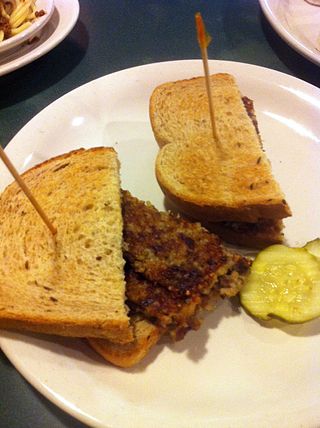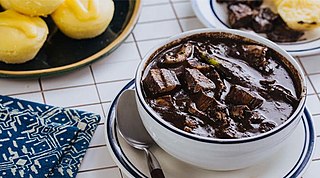
Haggis is a savoury pudding containing sheep's pluck, minced with chopped onion, oatmeal, suet, spices, and salt, mixed with stock, and cooked while traditionally encased in the animal's stomach though now an artificial casing is often used instead. According to the 2001 English edition of the Larousse Gastronomique: "Although its description is not immediately appealing, haggis has an excellent nutty texture and delicious savoury flavour".

Tripe is a type of edible lining from the stomachs of various farm animals. Most tripe is from cattle, pigs and sheep.

Offal, also called variety meats, pluck or organ meats, is the internal organs of a butchered animal. The word does not refer to a particular list of edible organs, and these lists of organs vary with culture and region, but usually exclude skeletal muscle. Offal may also refer to the by-products of milled grains, such as corn or wheat.

Meatloaf is a dish of ground meat that has been combined with other ingredients and formed into the shape of a loaf, then baked or smoked. The final shape is either hand-formed on a baking tray, or pan-formed by cooking it in a loaf pan. It is usually made with ground beef, although ground lamb, pork, veal, venison, poultry, and seafood are also used, sometimes in combination. Vegetarian adaptations of meatloaf may use imitation meat or pulses.

White pudding, oatmeal pudding or mealy pudding is a meat dish popular in the British Isles.
Romanian cuisine is a diverse blend of different dishes from several traditions with which it has come into contact, but it also maintains its own character. It has been influenced mainly by Turkish but also a series of European cuisines in particular from the Balkan Peninsula and Hungarian cuisine as well as culinary elements stemming from the cuisines of Central Europe.

Peasant foods are dishes eaten by peasants, made from accessible and inexpensive ingredients.

Pennsylvania Dutch cuisine is the typical and traditional fare of the Pennsylvania Dutch.

Goetta is a meat-and-grain sausage or mush of German inspiration that is popular in Metro Cincinnati. It is primarily composed of ground meat, steel-cut oats and spices. It was originally a dish meant to stretch out servings of meat over several meals to conserve money, and is a similar dish to scrapple and livermush, both also developed by German immigrants.

Kuyteav is a Cambodian noodle soup consisting of rice noodles with pork stock and toppings. It is a popular breakfast dish across all of Cambodia. The kuyteav can be found at marketplace stalls, roadside vendors, restaurants and in shophouses across the country, and is distinguished by its clear broth and array of herbs, aromatics and other garnishes and condiments.

Livermush is a Southern United States pork food product prepared using pig liver, parts of pig heads, cornmeal and spices. It is a regional cuisine that is common in Western North Carolina. It is typically consumed as a breakfast and lunch food. It has been suggested that livermush derives from scrapple. By law in North Carolina, the product must consist of at least 30% pig liver. Several festivals exist in North Carolina that are dedicated to the food.

Chinese Indonesian cuisine is characterized by the mixture of Chinese with local Indonesian style. Chinese Indonesians, mostly descendant of Han ethnic Hokkien and Hakka speakers, brought their legacy of Chinese cuisine, and modified some of the dishes with the addition of Indonesian ingredients, such as kecap manis, palm sugar, peanut sauce, chili, santan and local spices to form a hybrid Chinese-Indonesian cuisine. Some of the dishes and cakes share the same style as in Malaysia and Singapore, known as Nyonya cuisine by the Peranakan.

Dinuguan is a Filipino savory stew usually of pork offal and/or meat simmered in a rich, spicy dark gravy of pig blood, garlic, chili, and vinegar.

Faggots are meatballs made from minced off-cuts and offal mixed with herbs and sometimes bread crumbs. It is a traditional dish in the United Kingdom, especially South and Mid Wales and the English Midlands.

Knipp is a type of sausage made by mixing meat with grains (Grützwurst) related to Pinkel which comes from the Bremen and Lower Saxony regions of Germany.

Dumpling is a broad class of dishes that consist of pieces of cooked dough, often wrapped around a filling. The dough can be based on bread, wheat or other flours, or potatoes, and it may be filled with meat, fish, tofu, cheese, vegetables, or a combination. Dumplings may be prepared using a variety of cooking methods and are found in many world cuisines.

Embutido, or embotido, is a Philippine meatloaf made with ground pork and stuffed with hard-boiled eggs and sliced ham or various sausages. It is traditionally wrapped in aluminum foil and steamed, though it can also be baked.

















